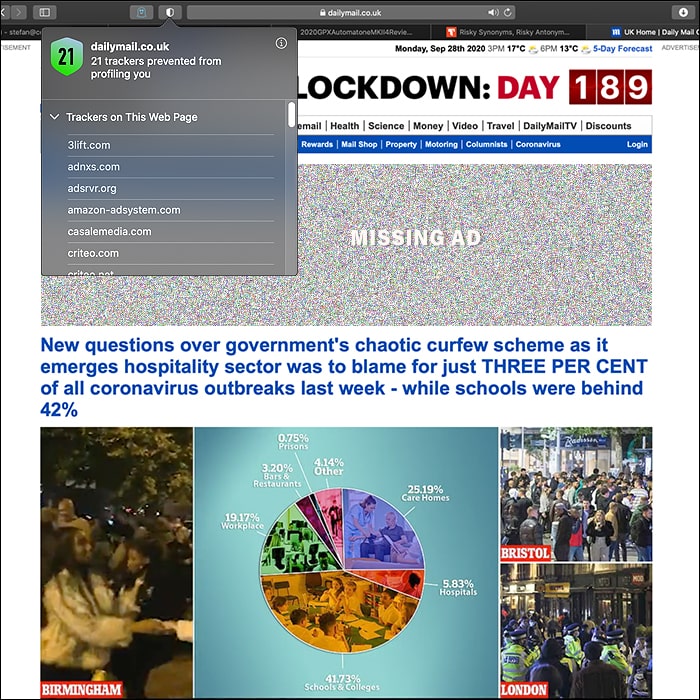5 Strategies for dealing with Ad Blockers

Like it or not Ad Blockers are here to stay and their impact is growing every day. Germany and Poland already passed 50% last year, the rest of the world’s browser-based audience is catching up fast, and there’s no mystery as to why all this is happening. Ads are generally woefully poorly targeted (I got a Pampers pre-roll ad on a Nine Inch Nails Vevo Video???), too invasive and pervasive, eat into your bandwidth costs, slow down you page loading speeds, often carry malware, and often snatch your identifiable details and sell them on to even more unscrupulous third parties, so it’s totally understandable why users might want to block them.
The reputation of the digital advertising industry is generally rather sullied, and will require considerable rehabilitation for consumers to accept them again in any way at all. Trust has been lost, and this at the very least needs to be regained.
The Strategies
1: Bar your site from those using ad blockers
Quite an irony here - to get a pop-up alert screen popping up over a pop-up ad, to serve notice to you that you will go no further unless you remove all your defences and make yourself vulnerable to the advertisers’ unscrupulous machinations again. Note that some media properties are claiming an ethical stance on advertising - and promising a certain quality level - however, with 3rd party ad-serving systems it is nigh on impossible to police all that advertising content / real-estate. There’s very few sites that I would turn off my ad blocker for - it’s usually just not safe at all!
2: Politely request that users disable their ad blockers for your site
A number of online magazines are doing this - explaining how they are almost entirely reliant upon advertising revenues to be able to offer their free-to-view service. Certainly a nicer way to encourage users, but still one that is unlikely to meet with much success, considering that all the dangers of 3rd party advertising would still be present. Equally importantly, very little content is totally unique - if you dig around the web enough you can usually find it somewhere else with less strings attached, so why would you compromise your safety when there are other alternatives available to you?
3: Go Native Apps
Many reason that they should just build an app, control their environment, shoe-horn in what they like, and force the users to watch pop-ups, pre-rolls and interstitials ad nauseam. Yet, there are already issues with this approach, as the App environment is open to influence from the App platforms - which can easily build in their own controls and user utilities / options. Moreover certain network and service providers have begun screening out ad content at source, as they find it overly costly to serve up all the extra bandwidth required by the advertising industry. Sure, you usually have more control than a browser-based experience, but then you do rely on users having to download, install and keep your app up-to-date. There is nothing either to stop Google and Apple bringing additional privacy feature into their app platforms to allow consumers to have more privacy control over their environment.
4: Go Native Advertising
This is really my favourite approach - going the advertorial route - with sympathetic inline features which seamlessly slip into the news feed, don’t distract unduly and maintain the tone and spirit of the surrounding content. As with any successful advertising, accurate targeting is key here, but if done well, could even be perceived as added value by some of the audience. In effect this is just sponsored content, in the best examples using the same editorial and art teams responsible for the other content in that section.
5: Single-source your ads, precisely target them, and serve them locally
If you’re going to stick to serving up ad banners, the only thing that will work is utilising a single-source platform like Affino, where your ads are served up natively by the same system that serves up all the content. Having an integrated in-house system also means in-house overview and management which should mean better quality of ads, and no malware or unscrupulous selling of details to third parties. A big proviso with this though as with any advertising is that this still won’t be successful if the ads aren’t properly targeted and served up to the absolutely correct audience within the correct context. Affino uses a granular topic-based system to ensure that ads are precisely targeted at the right content and meet the preferences of the audience perusing the self same content. In terms of the mechanical aspects of the ad serving - the knack is to make the ads indistinguishable from the content of the site, so that ad blockers can’t identify and filter them out. Of course if the ads aren’t properly targeted, the audience will get annoyed and look for better alternative elsewhere, so it’s never enough to simply just enforce your ad display!

Did you find this content useful?
Thank you for your input
Thank you for your feedback
Upcoming and Former Events
Affino Innovation Briefing 2024
Webinar - Introduction to Affino's Expert AI Solutions - Session #2
Webinar - Introduction to Affino's Expert AI Solutions - Session #1
PPA Independent Publisher Conference and Awards 2023
Meetings:
Google Meet and Zoom
Venue:
Soho House, Soho Works +
Registered Office:
55 Bathurst Mews
London, UK
W2 2SB
© Affino 2025

















